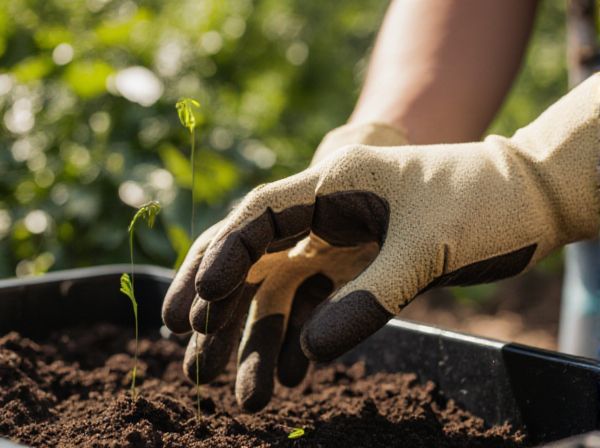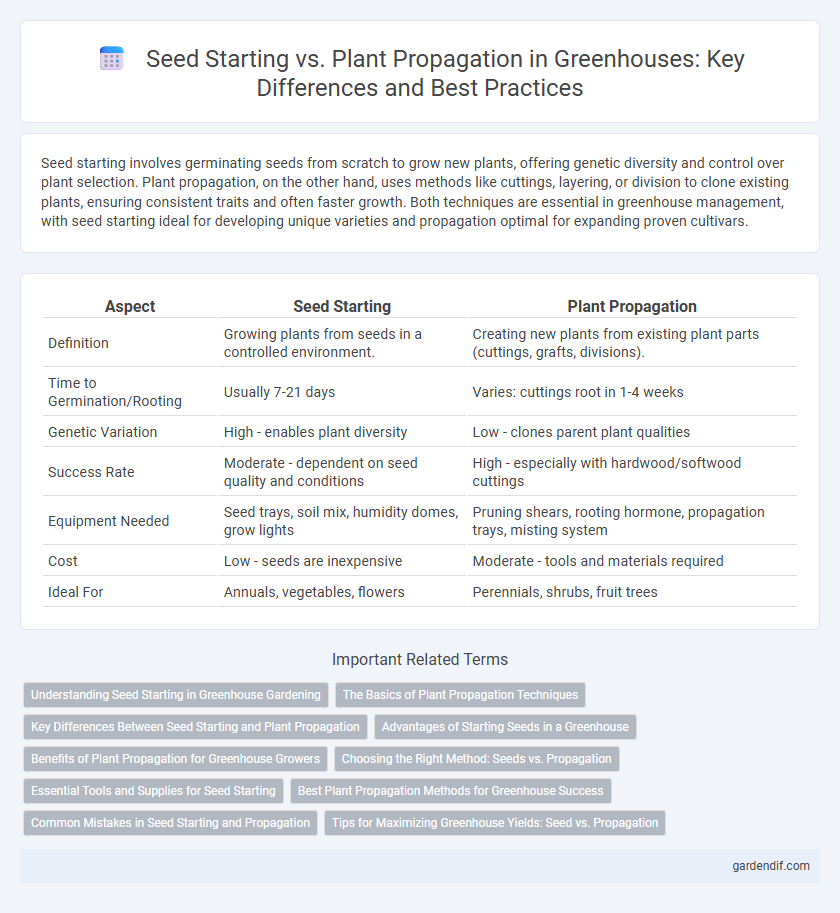
Seed starting vs plant propagation Illustration
Seed starting involves germinating seeds from scratch to grow new plants, offering genetic diversity and control over plant selection. Plant propagation, on the other hand, uses methods like cuttings, layering, or division to clone existing plants, ensuring consistent traits and often faster growth. Both techniques are essential in greenhouse management, with seed starting ideal for developing unique varieties and propagation optimal for expanding proven cultivars.
Table of Comparison
| Aspect | Seed Starting | Plant Propagation |
|---|---|---|
| Definition | Growing plants from seeds in a controlled environment. | Creating new plants from existing plant parts (cuttings, grafts, divisions). |
| Time to Germination/Rooting | Usually 7-21 days | Varies: cuttings root in 1-4 weeks |
| Genetic Variation | High - enables plant diversity | Low - clones parent plant qualities |
| Success Rate | Moderate - dependent on seed quality and conditions | High - especially with hardwood/softwood cuttings |
| Equipment Needed | Seed trays, soil mix, humidity domes, grow lights | Pruning shears, rooting hormone, propagation trays, misting system |
| Cost | Low - seeds are inexpensive | Moderate - tools and materials required |
| Ideal For | Annuals, vegetables, flowers | Perennials, shrubs, fruit trees |
Understanding Seed Starting in Greenhouse Gardening
Seed starting in greenhouse gardening involves sowing seeds in controlled environments to optimize germination and early growth, ensuring higher success rates compared to outdoor conditions. This method allows precise regulation of temperature, humidity, and light, promoting uniform seedling development and reducing transplant shock. Unlike other plant propagation techniques such as cuttings or division, seed starting focuses on initiating new plants from seeds, providing genetic diversity and cost-effective crop production.
The Basics of Plant Propagation Techniques
Seed starting involves germinating plants from seeds by providing optimal temperature, moisture, and light conditions, making it ideal for cultivating a wide variety of species in greenhouses. Plant propagation techniques also include methods such as cuttings, layering, and division, which produce genetically identical clones and can accelerate growth compared to seed starting. Understanding these basics allows greenhouse growers to select appropriate propagation methods based on plant type, desired growth rate, and genetic consistency.
Key Differences Between Seed Starting and Plant Propagation
Seed starting involves germinating seeds under controlled conditions to produce seedlings, while plant propagation encompasses various methods such as cuttings, division, and layering to multiply plants without seeds. Seed starting requires precise temperature, moisture, and light settings to support young seedling development, whereas propagation techniques often rely on the parent plant's viability and unique growth characteristics. Understanding these differences is crucial for optimizing greenhouse operations and achieving efficient plant production.
Advantages of Starting Seeds in a Greenhouse
Starting seeds in a greenhouse offers precise control over temperature, humidity, and light conditions, which significantly enhances germination rates and seedling vigor. The protected environment minimizes exposure to pests and diseases, reducing the need for chemical interventions and promoting healthier young plants. Consistent climate control in greenhouses enables earlier planting and extends the growing season, leading to stronger, more resilient plants compared to traditional plant propagation methods.
Benefits of Plant Propagation for Greenhouse Growers
Plant propagation in greenhouses offers greenhouse growers enhanced control over plant genetics, leading to uniform and high-quality crops. This method accelerates growth cycles and reduces costs by producing multiple plants from a single parent, maximizing space efficiency. Propagation techniques also improve disease resistance and adaptability, ensuring sustainable yields and healthier plants throughout the growing season.
Choosing the Right Method: Seeds vs. Propagation
Selecting the appropriate method between seed starting and plant propagation depends on the plant species and desired growth speed; seed starting offers genetic diversity and is ideal for annuals, while propagation ensures clones of superior plants, maintaining consistent traits. Seed starting requires controlled temperature and moisture for germination, whereas propagation techniques like cuttings or grafting demand specific conditions to encourage root development. Evaluating factors such as time, cost, and plant variety helps optimize greenhouse productivity by choosing seeds or propagation methods that align with cultivation goals.
Essential Tools and Supplies for Seed Starting
Essential tools for seed starting in a greenhouse include seed trays, quality seed-starting mix, and humidity domes to maintain optimal moisture levels. A reliable heat mat promotes consistent soil temperature necessary for germination, while grow lights ensure seedlings receive adequate light intensity to thrive. Additional supplies such as labels, spray bottles, and small hand tools support efficient seed care and transplanting.
Best Plant Propagation Methods for Greenhouse Success
Seed starting offers genetic diversity and vigorous root development, ideal for crops like tomatoes and peppers in a greenhouse environment. Plant propagation techniques such as cuttings, division, and layering enable rapid multiplication of disease-resistant or hybrid plants, ensuring uniformity and faster maturity. Selecting the best propagation method depends on plant species, desired growth rate, and greenhouse conditions to maximize success and yield.
Common Mistakes in Seed Starting and Propagation
Common mistakes in seed starting and plant propagation often include overwatering, which causes root rot, and inadequate light that leads to weak, leggy seedlings. Using poor-quality or contaminated soil can introduce pathogens, while improper temperature control slows or prevents germination. Failure to harden off seedlings before transplanting results in transplant shock, significantly reducing survival rates in greenhouse environments.
Tips for Maximizing Greenhouse Yields: Seed vs. Propagation
Maximize greenhouse yields by choosing seed starting for genetic variety and disease-resistant plants, while plant propagation ensures faster growth and consistent crop quality. Use heat mats and humidity domes for seed starting to enhance germination rates and maintain optimal moisture levels during propagation. Regularly monitor light intensity and temperature to create an ideal microenvironment tailored to each method, optimizing photosynthesis and reducing stress.
Seed starting vs plant propagation Infographic

 gardendif.com
gardendif.com